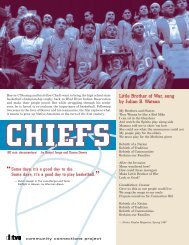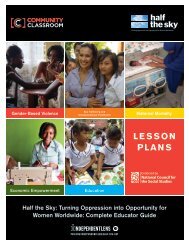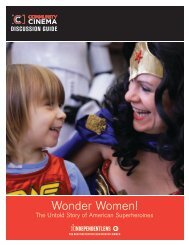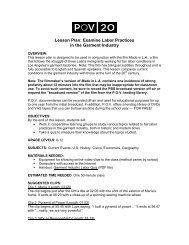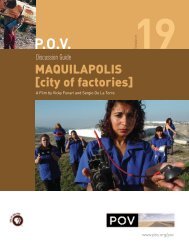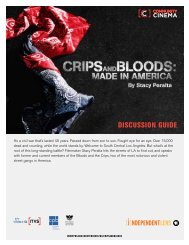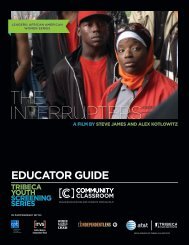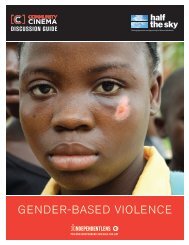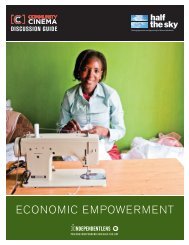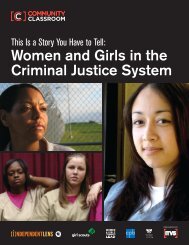Gender-Based Violence: Challenging Impunity - ITVS
Gender-Based Violence: Challenging Impunity - ITVS
Gender-Based Violence: Challenging Impunity - ITVS
You also want an ePaper? Increase the reach of your titles
YUMPU automatically turns print PDFs into web optimized ePapers that Google loves.
015<br />
HALF THE SKY<br />
<strong>Gender</strong>-<strong>Based</strong> <strong>Violence</strong>: <strong>Challenging</strong> <strong>Impunity</strong><br />
Extensions<br />
1. Is all violence created equal The <strong>Violence</strong> Against Women Act<br />
(VAWA) was enacted in 1994 to recognize the pervasive nature of<br />
domestic violence, dating violence, sexual assault, and stalking and<br />
to provide comprehensive, effective, and cost-saving responses<br />
to these crimes. VAWA programs were created to give law<br />
enforcement, prosecutors, and judges the tools they need to hold<br />
offenders accountable and keep communities safe while supporting<br />
victims. But if violence, assault, and stalking are already crimes, is<br />
it necessary to have a specific law that targets violence against<br />
women Why or why not<br />
--<br />
Instruct students to research the history and content of the<br />
<strong>Violence</strong> Against Women Act and how its provisions relate to<br />
existing criminal laws.<br />
--<br />
Ask students to compile data on the impact of the VAWA since it<br />
was enacted.<br />
--<br />
Explain that there is an ongoing debate about how and if the<br />
VAWA should continue to be funded, and if it should be expanded<br />
to include groups such as undocumented immigrants and<br />
members of the LGBT community.<br />
--<br />
Following their research, have students engage in a formal<br />
debate about the issue. Education World offers a selection of<br />
debate resources that provide guidelines and rules for classroom<br />
debates: www.educationworld.com/a_lesson/lesson/<br />
lesson304b.shtml.<br />
2. Why should boys and men care about ending genderbased<br />
violence <strong>Violence</strong> prevention requires a change in the<br />
social conditions that make violence normal and acceptable.<br />
Men and boys receive messages about relationships, violence,<br />
and power every day, and they also experience different forms<br />
of oppression: racism, classism, ableism, homophobia, etc. Men<br />
also enjoy certain privileges in institutions established by sexism.<br />
Generally speaking, men have greater access to resources<br />
and opportunities and are in a position to influence large social<br />
structures and institutions. As a result, they can play an important<br />
role in preventing violence against women.<br />
--<br />
Instruct students to research the root causes of violence against<br />
women and girls and examine the unequal power relations<br />
between men and women that lead to gender-based violence.<br />
--<br />
Have them identify negative consequences of violence against<br />
women in the lives of boys and men.<br />
--<br />
For additional resources and lesson plans on this topic, refer to<br />
the following websites:<br />
Man Up Campaign:<br />
www.manupcampaign.org<br />
White Ribbon Campaign:<br />
www.whiteribbon.ca<br />
“Guide to Engaging Men and Boys in Preventing <strong>Violence</strong> Against<br />
Women & Girls” by the Men’s Nonviolence Project, a project of<br />
the Texas Council on Family <strong>Violence</strong>:<br />
www.tcfv.org/pdf/mensguide/EngagingMenandBoys.pdf<br />
3. Journalism vs. Activism: Nicholas Kristof actively participates<br />
in Fulamatu’s story, even helping the authorities track down the<br />
accused child-rapist. He considers the journalistic ethics of his<br />
involvement and concludes that he is comfortable with his decision.<br />
• Have students view the entire <strong>Gender</strong>-<strong>Based</strong> <strong>Violence</strong> segment<br />
from Half the Sky: Turning Oppression into Opportunity for<br />
Women Worldwide<br />
• Ask students to consider the following questions: What do you<br />
think about Nicholas Kristof’s decision Is there a distance that<br />
journalists should maintain in order to remain objective Is it more<br />
ethical to simply observe and report or to actively participate<br />
• Share The Guardian article and photo essay, The Bystanders with<br />
your students and discuss what a journalist’s responsibility is when<br />
reporting a story.<br />
• The Bystanders Article:<br />
www.guardian.co.uk/media/2012/jul/28/guttedphotographers-who-didnt-help<br />
• The Bystanders Photo-Essay:<br />
www.guardian.co.uk/media/interactive/2012/jul/28/<br />
bystanders-photographers-who-didnt-help<br />
• Have students select a photojournalist featured in the story and<br />
consider if they agree or disagree with the journalist’s decision.<br />
• Ask them to draft a letter from perspective of the journalist to one<br />
of their photograph’s subjects explaining their decision: why they<br />
feel that it was the correct choice or what they wish they had done<br />
differently. The completed letters can be presented as a monologue.<br />
4. The silent war against women and girls. <strong>Violence</strong> against<br />
women and girls was a hallmark of the brutal civil war in Sierra<br />
Leone but these atrocities are not unique to this conflict. Rape<br />
has long been used as a weapon of war, and violence against<br />
women during or after armed conflicts has been reported in every<br />
war-zone. Between 250,000 and 500,000 women were raped<br />
during the 1994 genocide in Rwanda and between 20,000 and<br />
50,000 women were raped during the conflict in Bosnia in the early<br />
1990s. In 2009, the United Nations Security Council adopted a<br />
resolution classifying rape as a war tactic and posing grave threat




